
Tineidae is a family of moths in the order Lepidoptera described by Pierre André Latreille in 1810. Collectively, they are known as fungus moths or tineid moths. The family contains considerably more than 3,000 species in more than 300 genera. Most of the tineid moths are small or medium-sized, with wings held roofwise over the body when at rest. They are particularly common in the Palaearctic, but many occur elsewhere, and some are found very widely as introduced species.

Tineoidea is the ditrysian superfamily of moths that includes clothes moths, bagworms and relatives. There are six families usually included within it, Eriocottidae, Arrhenophanidae, Lypusidae, Acrolophidae, Tineidae and Psychidae, whose relationships are currently uncertain.
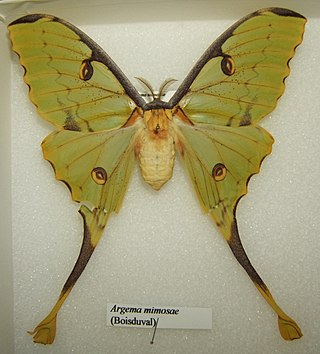
Argema mimosae, the African moon moth, is a giant silk moth of the family Saturniidae. Similar in appearance to the giant Madagascan moon moth, but smaller, this moth can be found widely in Eastern Africa and more locally in Southern Africa, including near the east coast of South Africa. The species was first described by Jean Baptiste Boisduval in 1847. An adult can measure 10 to 12 centimetres across its wingspan and 12 to 14 centimetres from head to the tip of its elongated tail-like second pair of wings. Its forward wings have a distinctive grey-coloured "furry" leading edge, giving a very rough surface, presumably for aerodynamic reasons. Apart from the eye-like markings on its wings, the colouring and shape of the wings give the appearance of a piece of foliage, especially the tail-like structures of the rearmost wings which resemble a dried out leaf stem - presumably for camouflage in its natural environment.
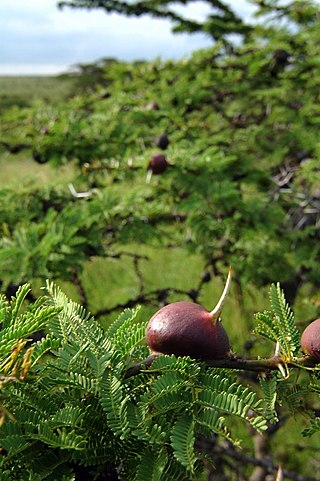
Vachellia drepanolobium, more commonly known as Acacia drepanolobium or whistling thorn, is a swollen-thorn acacia native to East Africa. The whistling thorn grows up to 6 meters tall. It produces a pair of straight spines at each node, some of which have large bulbous bases. These swollen spines are naturally hollow and occupied by any one of several symbiotic ant species. The common name of the plant is derived from the observation that when wind blows over bulbous spines in which ants have made entry and exit holes, they produce a whistling noise.

Tinea pellionella, the case-bearing clothes moth, is a species of tineoid moth in the family Tineidae, the fungus moths. This species has a cosmopolitan distribution, occurring nearly worldwide.
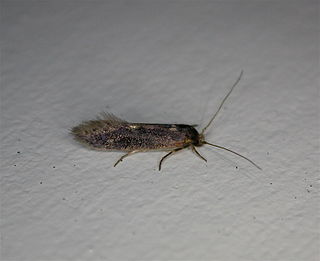
Opogona omoscopa is a moth of the family Tineidae.
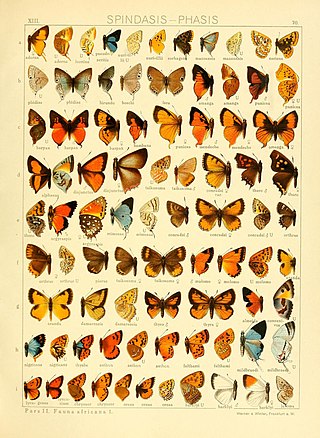
Iolaus mimosae, the mimosa sapphire, is a butterfly of the family Lycaenidae. It is found in southern Africa. The habitat consists of Karoo and savanna.
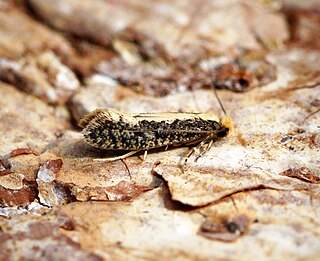
Monopis crocicapitella, the pale-backed clothes moth, is a moth of the family Tineidae described by James Brackenridge Clemens in 1859. It has a nearly cosmopolitan distribution. It was first described from the eastern United States. It is particularly destructive of fabric and clothes.

Argema is a genus of moths from the family Saturniidae, commonly known as moon moths. They are distinguished by long tails on their hindwings.

Karsholtia is a genus of moths of the family Tineidae. The genus contains the single species Karsholtia marianii. It is found in Norway, Sweden, Denmark, Germany, Austria, France and on Sicily.

Tinea pallescentella, the large pale clothes moth, is a moth of the family Tineidae. It is found in most of Europe. It is also present in western North America, where it has been recorded from California. There are also records from South America and Australia.

Nemapogon clematella, the barred white clothes moth, is a moth of the family Tineidae. It is found in most of Europe and in North America, where it has been recorded from Maryland and North Carolina. The habitat consists of woodlands.
Triaxomasia caprimulgella is a moth of the family Tineidae. It found in most of Europe, except Ireland, Luxembourg, Spain, Finland, the Baltic region, and the central part of the Balkan Peninsula.
Agrilus mimosae is a species of metallic wood-boring beetle in the family Buprestidae. The distribution range of Agrilus mimosae includes Central America and North America.
Chramesus mimosae is a species of crenulate bark beetle in the family Curculionidae. It is found in North America.
Diplotaxis mimosae is a species of scarab beetle in the family Scarabaeidae. It is found in Central America and North America.
Streptomyces mimosae is a bacterium species from the genus of Streptomyces which has been isolated from the root of a Mimosa pudica plant in Thailand.
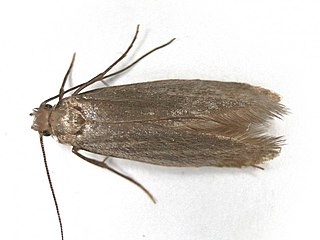
Tinea columbariella is a moth belonging to the family Tineidae. The species was first described by Wocke in 1877.
Tinea dubiella is a species of moth belonging to the family Tineidae.












